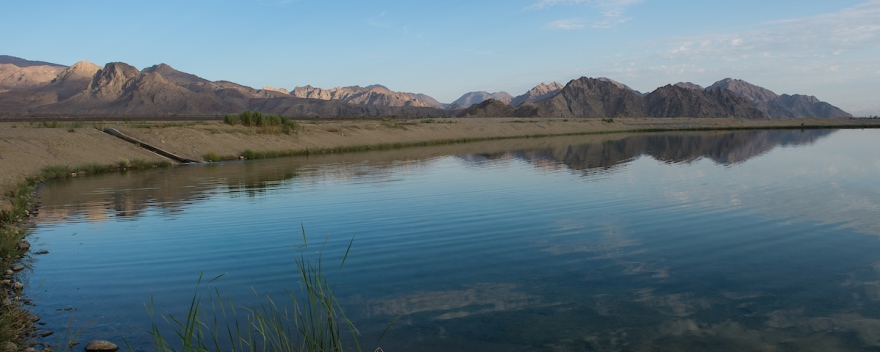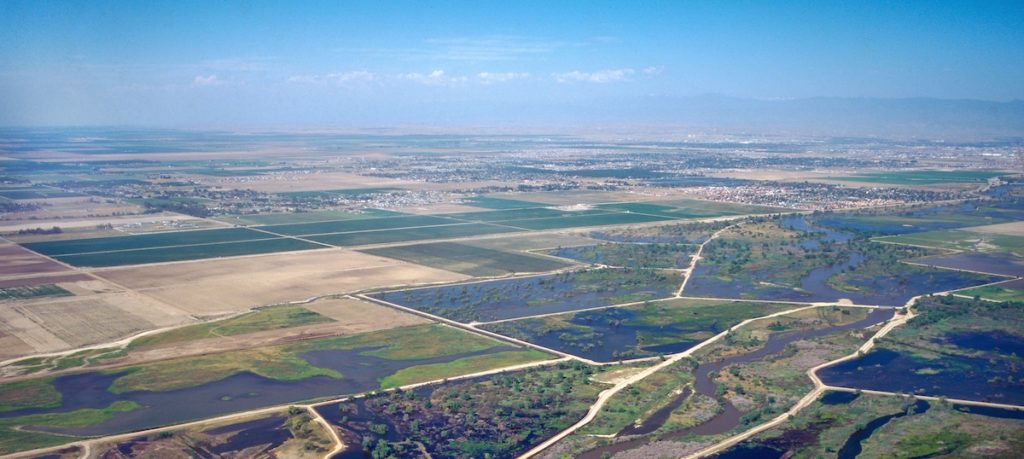While California’s recent drought is officially over, more intense rainfall means more rain is running off, rather than soaking into the ground. But what if some of this water could be collected to help recharge thirsty aquifers and mitigate the effects of overdraft?
At Driscoll’s, we’ve long advocated for responsible and collaborative solutions to groundwater management, and seek to grow in harmony with our communities. Water is a shared resource, and we all must work together at the local level to ensure it’s being managed well to keep our communities, businesses and ecosystems healthy for generations.
That’s why, over the past few years, we’ve been working with UC Santa Cruz, the Resource Conservation District of Santa Cruz County, the Pajaro Valley Water Management Agency, and an independent grower on the Bokariza-Drobac stormwater infiltration system — an innovative groundwater-recharge project in the Pajaro Valley.
News Keyword: Groundwater Recharge
State Water Board streamlines permitting process for diversions of floodwater and other high flows to support groundwater sustainability

Press release from the State Water Resources Control Board:
In an effort to expedite its
water right permitting process, the State Water Resources Control Board announced today it has streamlined requirements for applicants seeking to divert surface water to underground storage during floods and other high flow conditions.
The new measures are expected to directly benefit groundwater sustainability agencies (GSAs) and associated local entities striving to comply with the Sustainable Groundwater Management Act and replenish overdrafted groundwater basins.
The changes, which have no impact on existing laws and regulations, simplify the permitting pathway for capturing water during high flow events and storing that water underground, a process known as recharge. The streamlined approach also reduces application filing fees and annual permit and license costs.
“Achieving groundwater sustainability is one of California’s most pressing water management challenges,” said State Water Board Chair E. Joaquin Esquivel. “With a more variable hydrology expected, it’s critical that we prepare to capture floodwaters and other high flows, increase groundwater recharge, and better prepare for the effects of climate change. These permitting revisions will help make that process more nimble and efficient, while still protecting fish and senior right holders.”
California depends on groundwater for a third of its annual water supply, and significantly more during droughts. Parties who divert to underground storage and choose this less complicated approach must meet certain criteria and comply with a water availability analysis that monitors diversion of high flows during the winter.
Within the December-to-March time frame, applicants can choose between two diversion triggers: (1) when a river or stream’s daily flows exceed the 90th percentile and no more than 20 percent of the total stream flow is taken; or (2) a flood control agency determines actions are needed to protect the public.
The Sustainable Groundwater Management Act, which became law in 2015, empowers local agencies to manage groundwater resources for long-term sustainability. The long-term planning requirement provides a buffer against drought and climate change and contributes to reliable water supplies, regardless of weather patterns.
New groundwater recharge projects will likely be proposed and implemented by many GSAs as part of sustainable groundwater management. The new streamlined recharge permitting measures are designed to help GSAs obtain water right permits faster to help meet timelines for achieving sustainability.
GSAs also are encouraged to pursue “umbrella” permitting to cover dozens and possibly hundreds of diversion locations in a watershed and large areas of use, such as a water district. This makes broadscale recharge, particularly on agricultural lands, more feasible. It allows a water right holder to manage the diversion, storage and extraction of water on a landowner-by-landowner basis, from one high flow event to the next, or from year to year, without additional approvals from the Board. This enhances efficiency in permitting and annual reporting, gaging and measurement requirements, and accounting.
The State Water Board intends to hold an informational item on the streamlined permitting pathway as part of its regularly scheduled board meeting on November 19.
Information about recharge and underground storage can be found on the State Water Board website.
Putting the ‘Flood’ in Flood-MAR: Reducing Flood Risk While Replenishing Aquifers
Water management in California includes a diverse range of strategies that often requires a community of water experts to come together, collaborate, and solve issues ranging from infrastructure to operations.
Scientists, water managers, and other stakeholders had an opportunity to do just that during the 2019 Flood-MAR Public Forum held Oct. 28 to 29 in Sacramento. Hosted by the Department of Water Resources (DWR), the event provided a venue to discuss the implementation of Flood-MAR projects throughout the state.
Water officials work to assist recharge projects
“A technique that would help California manage floodwater and replenish groundwater has gained more attention, and removing barriers to the strategy known as Flood-MAR provided the focus for a conference in Sacramento. F
lood-managed aquifer recharge involves moving floodwater from surface streams onto land where it could percolate into a groundwater basin. Though the concept sounds simple, it brings complications that include managing the floodwater, finding appropriate land to accept it and establishing rights to the water involved. … ”
Read more from Ag Alert here: Water officials work to assist recharge projects
Recharging Depleted Aquifers No Easy Task, But It’s Key To California’s Water Supply Future
To survive the next drought and meet the looming demands of the state’s groundwater sustainability law, California is going to have to put more water back in the ground. But as other Western states have found, recharging overpumped aquifers is no easy task.
Successfully recharging aquifers could bring multiple benefits for farms and wildlife and help restore the vital interconnection between groundwater and rivers or streams. As local areas around California draft their groundwater sustainability plans, though, landowners in the hardest hit regions of the state know they will have to reduce pumping to address the chronic overdraft in which millions of acre-feet more are withdrawn than are naturally recharged.
GROUNDWATER RECHARGE: Balancing our depleted groundwater supplies and ecosystem needs
Groundwater managers across the state are looking to groundwater recharge as a potential solution to their community’s water challenges. However, there are concerns about how groundwater recharge in the age of SGMA actually works and how to ensure sufficient instream flows to protect those beneficial uses.
To address these questions, the Local Government Commission and the Clean Water Fund held a webinar to find out more about recharge, environmental flows, water rights, and permitting from a panel of experts. First, Stacey Sullivan from Sustainable Conservation talked about Flood MAR; next Sam Boland-Brien from the State Water Resources Control Board talked about the Environmental Flows Workgroup and permitting issues for groundwater recharge; and then Pablo Garza with the Environmental Defense Fund discussed policy issues related to groundwater recharge.
Read more at Maven’s Notebook here: GROUNDWATER RECHARGE: Balancing our depleted groundwater supplies and ecosystem needs
Ridgecrest: Banking water for LADWP? Kicinski talks groundwater with Rotary Club
““We are real close to defining exactly what stability is and how it is going to affect the valley,” said Indian Wells Valley Groundwater Authority Chair Ron Kicinski to the Rotary Club of China Lake on Wednesday. Kincinksi, who also serves on the IWV Water Board, made it clear he was speaking as a member of the IWVGA.
Specifically, Kicinski said the model at the moment is that sustainability is being defined at using around 12,000 acre-feet a year of water. … ”
Read more from the Ridgecrest Independent here: Banking water for LADWP? Kicinski talks groundwater with Rotary Club
Close to $3 million of water has reached Ventura County’s overstressed groundwater basin
“Close to $3 million worth of water has rushed down the Santa Clara River over the past several weeks to recharge groundwater basins in the Oxnard Plain. The release was part of a deal between the United Water Conservation District and Fox Canyon Groundwater Management Agency to help recharge aquifers still struggling after years of drought.
United told the Fox Canyon board it could purchase extra water from the California Water Project thanks to a particularly wet winter statewide. Fox Canyon then would buy roughly 15,000 acre-feet of water once it made it to spreading ponds near Oxnard and Camarillo. … ”
Read more from the Ventura County Star here: Close to $3 million of water has reached Ventura County’s overstressed groundwater basin
Kern County’s recharging basins come with a pesky price
“The recharging basins near Ming and Allen Rd. are filled with water. It’s a comforting reminder that we’ll be okay during the next drought, but with that security comes with a price.
“We have thousands of acres of surface water that can potentially breed mosquitoes,” Gene Abbott, the manager of Kern Mosquito and Vector Control (KMVC) said. … ”
Read more from Bakersfield.com here: Kern County’s recharging basins come with a pesky price
Putting a Tempest into a Teapot: Can California Better Use Winter Storms to Refill its Aquifers?
“The general long-term forecast for California as climate change intensifies: more frequent droughts, intermittently interrupted by years when big storms bring rain more quickly than the water infrastructure can handle. This bipolar weather will have profound implications for the state’s $50 billion agriculture industry and the elaborate network of reservoirs, canals, and aqueducts that store and distribute water. A system built for irrigation and flood protection must adapt to accommodate conservation.
“The effects of climate change are necessitating wholesale changes in how water is managed in California,” the state Department of Water Resources wrote in a June, 2018 white paper. … ”
Read more from the Stanford’s Bill Lane Center for the West here: Putting a Tempest into a Teapot: Can California Better Use Winter Storms to Refill its Aquifers?

